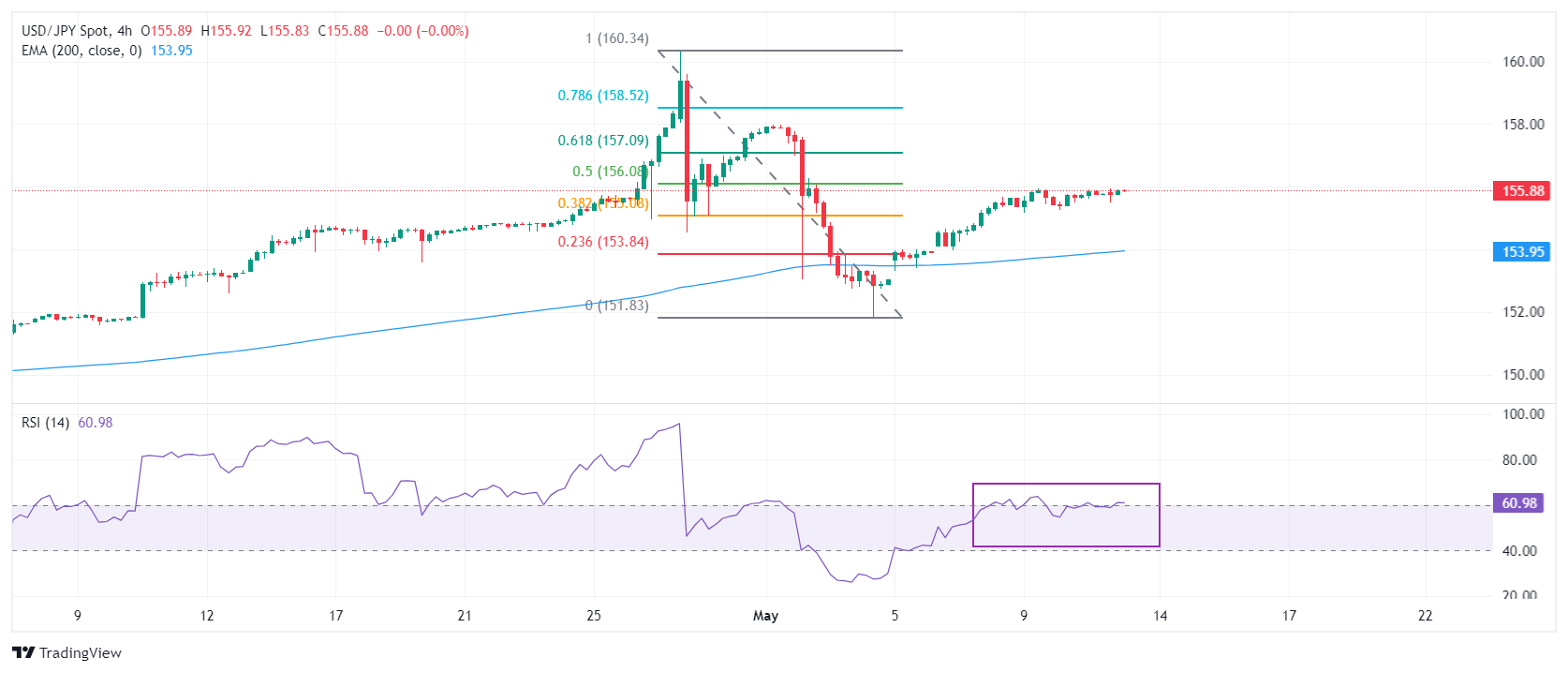Japanese Yen falls amid uncertainty over BoJ extending rate-hike spell

- The Japanese Yen drops further as investors remain uncertain about BoJ extending the policy normalization process.
- Japan’s economy is estimated to have contracted by 0.4% in the January-March period, exhibiting a weak start to the year.
- The US Dollar will dance to the tunes of the US consumer and producer inflation data.
The Japanese Yen (JPY) falls further to 156.00 against the US Dollar (USD) in Monday’s American session. The USD/JPY pair holds gains as investors worry that rising inflation in the Japanese economy is mainly the outcome of a weak Yen, which should be driven by a wage growth spiral for price pressures to sustain steadily above the desired rate of 2%.
The communication from Bank of Japan’s (BoJ) Summary of Opinions (SOP) for the April meeting, released last week, indicated that inflationary pressures in Japan are majorly induced by weak Yen. Policymakers discussed possible scenarios for further rate hikes. One member said the extent of consumption recovery toward the latter half of this year will be key in considering the timing for the next policy change.
This week, the outlook of the Japanese Yen will be guided by preliminary Japan’s Q1 Gross Domestic Product (GDP) data, which will be published on Thursday. The consensus suggests that the Japanese economy contracted by 0.4% in the January-March period after expanding by 0.1% in the last quarter of 2023. On an annualized basis, the Japanese economy is estimated to have contracted significantly by 1.5%.
Daily digest market movers: Japanese Yen stays on backfoot despite soft USD
- The Japanese Yen extends its downside to near 156.00 against the US Dollar even though the Greenback is on the back foot due to deepening concerns over the United States labor market strength after weak Nonfarm Payrolls (NFP) for April, lower Job Openings for March and a large number of individuals claiming jobless benefits for the first time for the week ending May 3. The US Dollar Index (DXY), which tracks the US Dollar’s value against six major currencies, drops sharply to 105.00.
- In the current scenario, easing tight labor market conditions is unfavorable for the US Dollar and bond yields as it exhibits softening inflation outlook, which strengthens speculation for the US Federal Reserve (Fed) returning to policy normalization. The CME FedWatch tool shows that the September meeting will be the earliest when interest rates will be lowered from their current range of 5.25%-5.50%.
- This week, investors will focus on the US Producer Price Index (PPI), Consumer Price Index (CPI) and Retail Sales data for April. The US PPI data releasing on Tuesday will exhibit the change in prices of goods and services by business owners. On Wednesday, consumer inflation and Retail Sales data will be released, which will provide fresh cues on the interest rate outlook.
- Economists expect that monthly headline and core CPI rose by 0.3% in April, slower than March’s reading of 0.4%. Annual headline CPI is forecasted to have softened to 3.4% from 3.5% in March. In the same period, the core inflation that strips off volatile food and energy prices is anticipated to have decelerated to 3.6% from the prior reading of 3.8%.
- Hot inflation data will offset investors’ optimism for Fed rate cuts in September built on easing labor market data. On the contrary, soft inflation figures will strengthen investors’ confidence in the Fed reducing interest rates from September. Traders could raise bets for the Fed to start lowering borrowing rates in July if the inflation data decelerates more than expected.
- In the Monday’s American session, Fed Vice-Chairman Phillip Jefferson emphasized keeping interest rates in the restrictive territory until it get evidence that inflation is ebbing.
Technical Analysis: Japanese Yen’s long-term outlook remains strong
The Japanese Yen retraces 50% downside move from April’s low of 160.32 against the US Dollar, where investors suspect that the Japanese officials intervened. Investors suspected a probable intervention after the BoJ data suggested that it spent nearly 60 billion Yen to prevent further downside. The USD/JPY pair fell to near 151.82 after the suspected stealth intervention.
The 200-period Exponential Moving Average (EMA), which is currently trading near 156.00, acted as a major support for the US Dollar bulls. The cushion near the 200-EMA suggested that a positive long-term outlook is intact.
The 14-period Relative Strength Index (RSI) hovers near 60.00. A decisive break above this level will trigger the upside momentum.
Economic Indicator
Gross Domestic Product (QoQ)
The Gross Domestic Product (GDP), released by Japan’s Cabinet Office on a quarterly basis, is a measure of the total value of all goods and services produced in Japan during a given period. The GDP is considered as the main measure of Japan’s economic activity. The QoQ reading compares economic activity in the reference quarter to the previous quarter. Generally, a high reading is seen as bullish for the Japanese Yen (JPY), while a low reading is seen as bearish.
Next release: Wed May 15, 2024 23:50 (Prel)
Frequency: Quarterly
Consensus: -0.4%
Previous: 0.1%
Source: Japanese Cabinet Office
